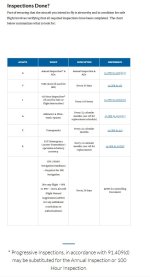Let's say you're following the recommendations of Vic Syracuse's truly excellent Maintenance Handbook for Van's RV Aircraft and performing progressive maintenance. Every month, you do a little something, inspect a little something, replace something that wore out.
Your condition inspection was in, say, July. In October, you open up the tail and replace the ELT battery. While you're there, you inspect and lubricate the rod ends, check the jam nuts, etc. What do you log then?
And what do you log the following July? The regs say you have to do an inspection annually, and that inspection must include certain things. I can't claim to have completed in July an inspection that includes data gathered in October, can I? It doesn't seem right.
Or am I then just obligated to keep the new schedule and look down the tail every October? The excuse for doing it in October had been that you had to change the ELT battery, but you don't have to do that every October.
Anyway, what should the logbook say?
Your condition inspection was in, say, July. In October, you open up the tail and replace the ELT battery. While you're there, you inspect and lubricate the rod ends, check the jam nuts, etc. What do you log then?
And what do you log the following July? The regs say you have to do an inspection annually, and that inspection must include certain things. I can't claim to have completed in July an inspection that includes data gathered in October, can I? It doesn't seem right.
Or am I then just obligated to keep the new schedule and look down the tail every October? The excuse for doing it in October had been that you had to change the ELT battery, but you don't have to do that every October.
Anyway, what should the logbook say?






